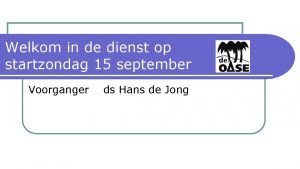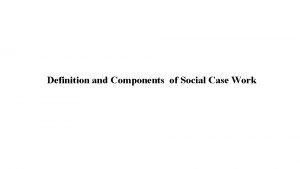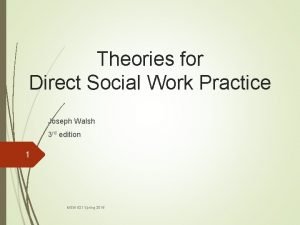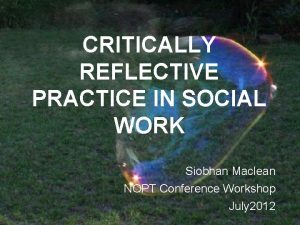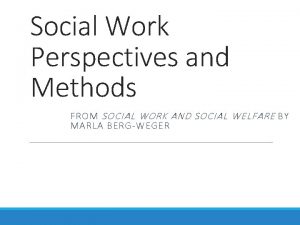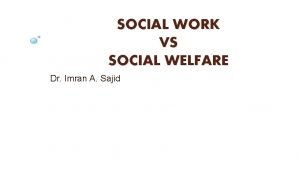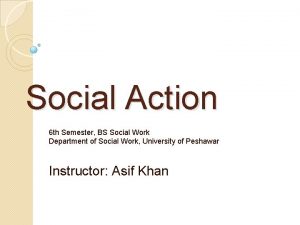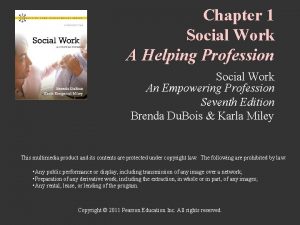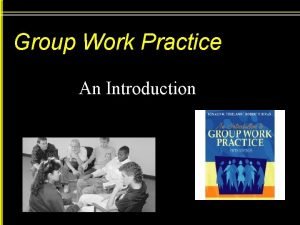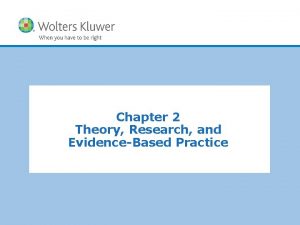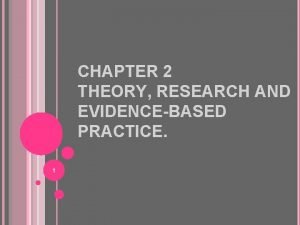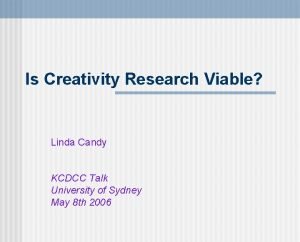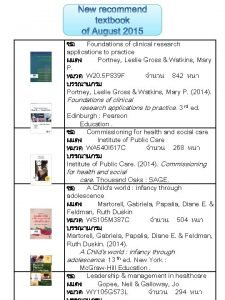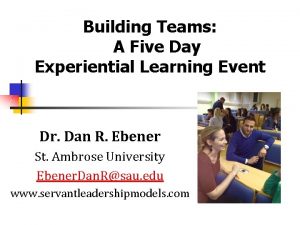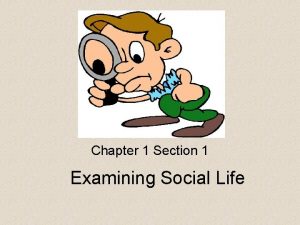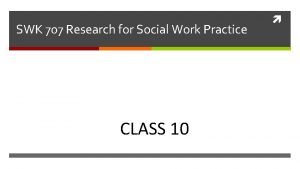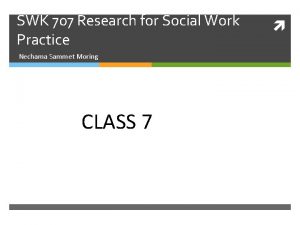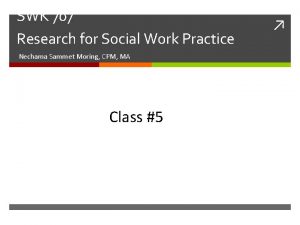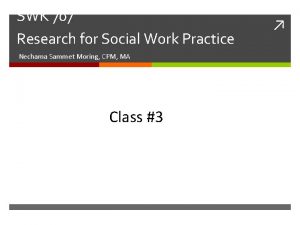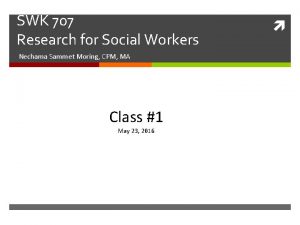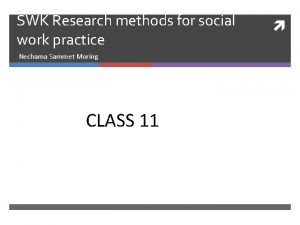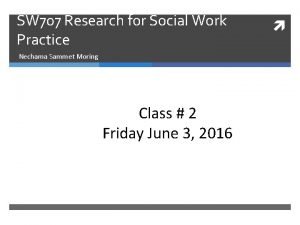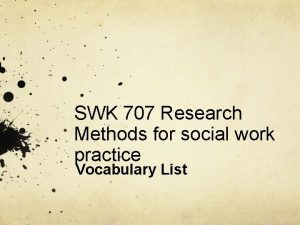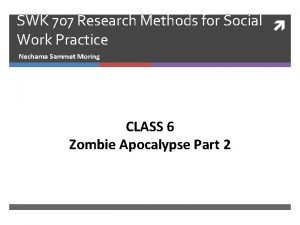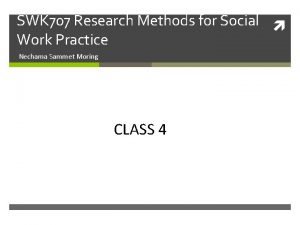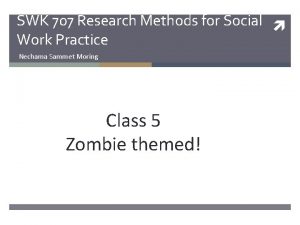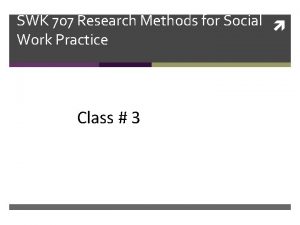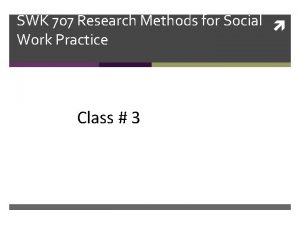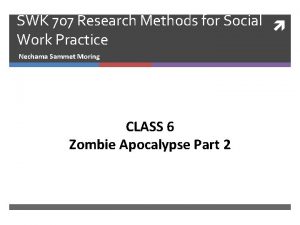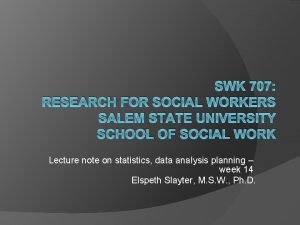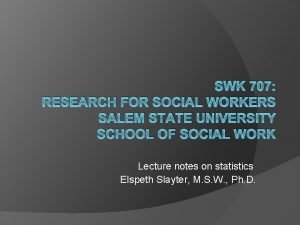SWK 707 Research for Social Work Practice Nechama


















































































































- Slides: 114

SWK 707 Research for Social Work Practice Nechama Sammet Moring CLASS 7

Tonight’s Plan 6: 00 -6: 10 Check in, logistics, any questions about assignment 2 6: 10 -6: 20 mid-semester eval feedback 6: 20 -7: 00 qualitative coding 7: 00 -7: 30 review 7: 30 -7: 40 break 7: 40 -8: 00 take and review quiz 8: 00 -8: 55 analyzing quantitative data: part 1 8: 55 self-evals

Logistics question Do we want a peer review “lab session”? It would be optional

Literature review: Good technique ü Be thorough ü Be selective (if overwhelmed w/existing studies) ü If not overwhelmed with existing studies - piece things together to show you will fill the gap ü Compare, contrast & synthesize, synthesize! ü Don’t provide me with a list Slayter 4

Mid-semester eval: Some things we can’t change The time of class (though I understand it’s late) The reading (though I can select one “most important” text-book type reading we’ll concentrate on. Sample studies/articles are vital to read) Research is difficult/more science-y than social work, and research writing is a stretch

Some things we can change More guidance on assignments (see guidelines and grading rubric I sent out) More social work examples (please help me out on this!) More time on literature review (we’ll do week 10, before final assignment) More time on research questions; when and why to use different research designs (we’ll do this in class 9, related to your final paper) Power points will be up by 3 pm I am teaching research in the fall-please sign up for my class!

Some points of disagreement Group work (3 love it; 2 hated it) Review at the beginning of class (2 loved it; 2 hated it) Zombies (2 love it; 3 hated it)

Whats going well General agreement that we’re generally meeting learning goals Peer sharing is helpful Communication “mixing up” class

Strengths Qualitative Research Used in exploratory research to examine a question or construct about which little is known Useful in formative stages of research to gain a better understanding of cultural variations, appropriate language, and meaningful categories Open-ended questions can provide context and depth to questions of interest Documents individuals’ responses in own words, thoughts, phrases

Process. Grounding of QL research A question arises Re-consideration of theory, literature from findings in theory, literature – provide justification Hone question, aims design, sample, few questions chosen with care Ongoing Data collection, analysis – re-development of questions - simultaneous

Qualities Important for Qualitative Research Good conceptual understanding of the goals of research Ability to develop rapport with participants Ability to listen and absorb information Empathy Intuitive sense to build conversation Ability to analyze, synthesize and utilize information immediately (ie your interviewee says something unexpected) Reflexivity-sense of yourself, your own opinions, experiences, background and life experiences, willingness to acknowledge your opinion as simply one of many, formed as a result of your life experience (i. e. my disability research is different than someone else’s because I am a family member, a woman, able-bodied etc)

Qualitative Research Techniques Interviews Informal Unstructured Semi-structured/guided Formal/structured Focus groups http: //www. huffingtonpost. com/2014/09/22/pets-are- people-too_n_5842444. html Observation: Participant observation Unobtrusive observation

Semi-structured Interviews Based on a set of questions derived from theory, previous research, and experience Interview guides have specific topics (constructs) to cover, using specific questions as prompts Provides minimally directive framework that enables both researcher and participant to define questions and generate new ideas partnership

Interview tips Do your homework beforehand! Get a sense of your interviewee’s priorities and be prepared to address these topics Begin with general questions to establish rapport and move to more specific/more controversial questions List constructs (concepts of importance) and develop questions that address these constructs. Be prepared to address the construct in more than one way. Construct: Impact of dog ownership on quality of life Questions: How does dog ownership impact your quality of life? What are some of the pros of having a dog? What are some of the ways that having a dog impacts you negatively? How has having a dog changed your quality of life?

More interview tips Practice beforehand-interview someone else using your guide and ask for honest feedback re: clarity, flow etc. Open-ended (as opposed to close-ended) questions allow participants to express and explore their ideas. Close-ended questions have more potential to influence responses. (“What are some of the impacts of poverty on young mothers? ” Answer: talk, talk vs. “does poverty impact young mothers? ” Answer: Yes. ) How, why, what, describe….

Redirects and prompts in interviews The fine art of re-directs: I see, so you (their thing). Was there where/when you first (your thing)? I want to be conscious of your time, and I have just a few more questions about (your thing) The fine art of prompts: Tell me more. Ummhmmm How so? Can you expand on that? Can you give me an example?

Approach often determines data analysis Inductive-start with themes or conceptual model already identified (usually from lit search or similar) and use data to explore the model Content analysis Deductive-build theory from the data itself Grounded, coded theory

Theme identification in qualitative research Importance of distinguishing between qualitative and quantitative Theme identification vs. concept measurement Beyond counting… Letting themes “rise up” from the data Letting the collective voice of study respondents define what themes are in answer to questions Can be confusing – demographic data sometimes included as qualitative 18

Sample coding sheet Code 1 Code 2 Code 3 Demographic data Interview 1 Interview 2 Interview 3 Interview 4

Coding process • Codes: Identifying anchors - key points of the data gathered • Concepts: Collections of codes of similar content – allows data to be grouped • Categories: Broad groups of similar concepts used to generate a theory or relate back

On inductive, deductive research Deductive Inductive

Inductive vs deductive coding Deductive-starts with theory, code book already built from the literature, your theory; content analysis Inductive: -starts with observation, code book and theory is built from the transcripts, grounded theory

Interpreting qualitative data 1. Become saturated 2. Look for patterns – constant comparison 3. Corroborate/legitimate themes 4. Represent the accounts accurately via checking back 1. 2. 3. Self Team Member checking

Pure qualitative data analysis • Become grounded in the data • “Open coding” • • Express data/phenomenon in concept form Categorize concepts that are relevant to question Allow understanding to emerge from close study of the data • “Axial coding” for subcategories or larger themeing Discover patterns, themes • “In-vivo” coding

How to begin the coding process 1. Read memos, interviews, other (no notes) 2. Read memos, interviews, other (make notes) 3. Re-read (look for themes within transcript) 4. Re-read (look for themes across transcripts) In grounded theory: Sensitizing concepts Review your thoughts with your team Do you agree on themes in transcripts? Do you agree on themes across transcripts How do these themes connect?

Let’s try it! Content analysis Finding themes, commonalities in the first encounter “bucket” Code book pre-built from my literature search I totally did Code alone, then compare and discuss with a partner

Discuss content analysis coding What did we learn? What did we miss? What about outliers?

Let’s try it again: grounded coding This time, you have a complete interview, and we don’t have a code book pre-developed Read your transcript once through On your second read, make notes about codes Working with a partner, group each of your codes into themes to create a code book What is important? Ok to have a “wild card” theme

Discuss grounded theory What did we learn? What did we miss? Outliers?

Making qualitative data more rigorous (free of bias; scientific) Inter-coder reliability and ways to check this (group coding, 2+ people code all transcripts and discuss; 1 person codes most with a second person to “spot check”) Good decisions in purposive sampling Triangulation of data (i. e. multiple data sources and data collection methods yield the same findings) Respondent verification (people you interviewed read and review your work) Saturation (the point at which new themes stop emerging) and coding a few past saturation Positionality and reflexivity (self-awareness; knowing your “blind spots” and designing your research to check your own blind spots)

Use of software programs Nvivo, Atlas-ti Document loading, linkage Open coding, axial coding, In vivo coding What is different with the software? Assign categories to transcripts – comparisons Word count, auto-code features (slippery slope) Pull documents together by theme/filter Drop-down codebook Code by recording location Mapping of code relationships

Review

How to pick a study design Study design is guided by your research question: what is the best way to answer this particular question with the least amount of bias? Funding considerations: what is practical and feasible? Do you have the resources you need for “gold standard” designs? If not, what is the most feasible, highest quality Plan B?

Quantitative research: time factors Cross-sectional Longitudinal Measures a single time point Cannot determine causation or correlation, just what’s happening right now Research designs that follow people over time Subject to loss to follow up bias (attrition) Ex: I do a survey to investigate how many people at the homeless shelter have experienced domestic violence in the last year Ex: I want to know if there’s a connection between experiencing domestic violence and homelessness, so I follow a group of DV survivors and a matched group who hasn’t experienced DV and track homelessness rates for 5 years

Quantitative designs: “levels” Preexperimental • Testing variables without a control group, so nothing is being compared (often the most feasible design, like pre and postintervention testing) Quasiexperimental • 2+ groups being compared but group assignment is not random (so there could be differences between groups) experimental • 2 + groups being compared with random assignment (you have an equal chance of being in either group). Considered a gold standard (but can have ethics issues)

Pre-experimental example I’m a social worker in a domestic violence shelter and I run a group for survivors. My agency is particularly interested in preventing homelessness among survivors, given that domestic violence is a leading cause of family homelessness. Many of my clients have told me privately that they don’t have basic financial literacy, because their abusers controlled the money, and some find financial decisions re-traumatizing. I have a colleague who works with adolescent parents has been using a basic financial literacy course with her clients, and I want to adapt it to my population by making it trauma informed and offering one-on-one support, as well as teaching the curriculum. My supervisors and I don’t feel it would be ethical to only offer this intervention to some clients (no comparison group), so I give all shelter clients a pre-test measuring their financial literacy, teach the class during group time, then give a pre test. We also track homelessness rates among past clients that we are able to survey.

Quasi-experimental example There was positive response to my trauma informed financial literacy class among shelter clients, so my supervisors want to expand it to our drop in groups. They also want to know if just the curriculum itself is effective without the on one counseling I provide. We decide to offer one group just the course, and another group the course and the on one support (in other words, we are comparing 2 groups). We have a daytime group, which mostly attracts survivors who are not working outside the home, and an evening group, which mostly serves working survivors. (In other words, there are categorical differences between the groups and assignment is not random. ) All participants take a a pre-test and a post-test and our agency tracks homelessness rates among past clients that we are able to contact.

Experimental example The social work department at an agency that serves people with mental illness is interested in supporting parents with SMI to improve their family functioning, increase parenting skills and meet their own goals. We offer traditional case management services but we are noticing that outcomes are not really improving. We decide to start a peer to peer mentoring program, and we train 2 parents with SMI to serve as mentors. We advertise the program, and when 50 parents have expressed interest, we flip a coin for each client. If the coin lands on heads, the person is enrolled in the peer mentoring program (random assignment). If the coin lands on tails, the person is placed on a waiting list for peer mentoring and is given traditional case management right away. (comparison group) All parents take a pre-test assessing their family functioning and parenting skills, and at 3 points during the year, all parents are asked to rate their progress towards their self-identified goals. Everyone takes a post-test at the end of the year. Then, people on the waiting list get peer mentoring and the peer mentoring group gets case management.

Qualitative designs: Harriet the spy to anarchist paradise Harriet the Spy Anarchist paradise Ethnography phenomenology • Gain understanding of a group or culture by observing (participant observation or observation) and sometimes interviewing • Gain in-depth understanding of what it’s like to be XYZ, the experience of XYZ. Follows a small number of individuals in depth to gain deep understanding of the phenomenon Traditional qualitative work • Can be more or less participant directed; traditional methods like interviews and focus groups. Participant always knows they are participating in research and they tell you what its like Participatory action research, CBPR • Participatory action research is collaborative, done with communities. Combines research and action; research findings are applied to solving problems • Community based participatory research is collaborative with involved communities, less action-focused

Ethnography example My city is experiencing a rise in heroin use and death from overdoses. I want to understand it, so I hang out in methodone clinics and at the “hangout” spots where people with substance use disorder congregate. I observe and take a lot of notes over a period of 2 months, and I also interview 20 heroin users about their lives. My goal is to understand the “culture” of heroin use in Boston.

Phenomenology example I want to understand the experience of being a heroin user, so I identify 4 users and spend hours a day with each of them over 2 months. I get to know them well, conduct multiple interviews, and gain an in-depth understanding of their experiences and lives. There is a lot of depth to this approach and I get very rich data, but it may not be very generalizable.

Traditional qualitative methods example I want to understand the heroin epidemic and what is driving it, so I conduct interviews with individuals who use heroin, people who consider themselves addicts in recovery (not currently using heroin) and emergency room physicians. I ask everyone about the barriers to substance abuse treatment, what they feel needs to be done to surmount the barriers, and their views on whether narcan should be distributed to reduce overdose deaths.

Participatory action research example I’m a social worker who works with adults who abuse heroin and are high risk for overdose, which can be deadly, because they have either OD’d in the past or use heroin more than twice a day. I run a drop in group and my clients often discuss the trauma of seeing friends OD and their interest in harm reduction strategies like making narcan available. Working with my clients, we design a study to explore whether distributing narcan is feasible, and if having narcan available would prevent OD deaths. We’re also interested in barriers to using narcan and how they can be overcome. Our findings suggest that narcan distribution is feasible, and that people would feel more comfortable accessing it if it was de-criminalized. We use these findings to advocate for a bill allowing narcan to be sold over the counter at the state house, and present our findings at the Boston Medical Center ER, urging them to prescribe narcan to all people who answer yes to a standardized question about heroin use on admission.

Community based participatory research (CBPR) example The same as the participatory action research example, except without the last “action” steps (advocating for the bill and at the ER). Focused on partnerships with communities, collaborative exploration, research. Based on the premise that people experiencing something are the best authorities about that thing.

Program evaluation Process (formative) Focused on the process of the program (are things happening as they are intended to? ) Example: In the financial literacy for DV survivors example, I look at whether people are coming to the group, whether the teacher is staying on track, if people no show to their private sessions, why? , barriers to attending class Outcome (summative) Focused on the results of the program (are we causing the changes we hope to cause? ) Example: In the financial literacy program for DV survivors, are we meeting the actual short-term goal (improved financial literacy) and the long-term goal (reduced rates of homelessness)

Quiz: You got this!!

Why do statistics

Overlapping goals in course: Critical consumption of research AND skills to evaluate practice Learn to critically consume research Learn to develop practice evaluation plans Consider the process of evidence-based practice beyond evidencesupported interventions

Starting to think about Process Outcome

We will do no math. Remember:

4 basic types of statistical tests: Description • Mean, standard deviation • Median, Mode • Percentage, frequency Correlation • Pearson’s correlation Comparison • Student’s t tests • Chi-square tests • ANOVA • Odds ratios Prediction • OLS regression • Logit regression

Univariate & Descriptive Univariate - describe individual variables Descriptive – describe, summarize data Frequency Range Percentage Central tendency (simple mean, median mode) Standard deviation

Descriptive statistics: purpose Describe whats happening Don’t say anything about relationships But before you can describe relationships, you hae to describe the data itself

Descriptive statistics Usually deals with each variable individually (not in relationship to each other-that’s inferential) Establishes patterns for each variable Help us make sense of large amounts of data by showing what’s typical and also the exceptions that exist for each variable Can provide the number or rate extent of an occurrence aggregate the data-just means adds it up and presents it Demographic information

Cheat sheet: Descriptive statistics Type: Used for: Frequency Counting Mean/average, median or mode Measure of central tendency Variable structure: Any Continuous

Review of kinds of variables Dichotomous-one of 2 options (i. e. yes/no) Nominal-mutually exclusive categories (zombie, human, sheep, elephant) Ordinal-mutually exclusive categories that go in order (1 st, 2 nd, 3 rd) Continuous (interval)-rank ordered, mutually exclusive and there is the same amount of difference between each variable, like height, 5, 5’ 1, 5’ 2 etc) Ratio-continuous but with a fixed 0 (number of kids, 0 - 19)

Dependent and Independent Variables Quant research is about demonstrating relationships between variables Independent variable just exists. (I am either undead or not) Dependent variable is influenced by the independent variable (whether or not I’m undead has a relationship to if I eat brains or not) A change in the independent variable leads to a change in the dependent variable

What is a frequency measure and what do you do with it? Counts How do you report these How often something occurs results in a way that is accessible to the reader? Numbers of people/places/things with: a certain characteristic a certain set or combination of characteristics Percentages Mean (SD), median, mode

frequency You’ll need a scoop of skittles and 2 bags of fruit snacks Calculate the frequency of each color in your bag by lining up first the skittles and then the fruit snacks in color order on the table Count the total number of candies on your grid. This is the frequency of each color within a scoop of candy

Frequency part 2 Now, let’s pretend that each color group is an outcome or characteristic you are interested in, for example an age range or a specific trauma symptom. You now know how many people of each age group are in your sample/how many people in a trauma group are experiencing sleeplessness, hyper-vigilance etc Sticking with the trauma group example, now let’s pretend the skittles represent cisgender women and the fruit snacks represent trans women. While this method does NOT let you analyze relationships, you might be able to get a sense of whether trans and cis women have the same pattern of symptoms

Table 1: Demographics of Elders with IDD/SA Sociobehavioral model Predisposing Characteristics Enabling resources Need factors ***p<. 001 *p<. 05 Variable IDD/SA (N=350) No. IDD/SA (N=48, 014) Test Gender (male) 238 (68%) 25, 064 (52%) OR=1. 9*** Mean age (SD) 70 (5) 73 (7) t=4. 5* Race (white) 260 (74%) 28, 741 (59%) OR=1. 9*** (SSI/SSDI) 199 (57%) 29, 131 (61%) NS Dually eligible 303 (87%) 43, 226 (90%) OR=0. 7* FFS coverage 262 (75%) 34, 283 (71%) NS Low state SA coverage 141 (40%) 16, 899 (35%) OR= 1. 2* Urban location 213 (61%) 30, 027 (63%) NS SMI diagnosis 151 (43%) 7, 540 (16%) OR= 4. 1*** Long-term SA diagnosis 19 (5%) 5, 549 (12%) OR= 0. 4***

Rodriguez & Murphy: Frequencies? Ranges?

Measures of central tendency Mean=mathematical average (add up all scores, divide by number of scores) median = the score in the exact middle of all the scores, the midpoint Mode=the score that occurs the most; often used with nominal variables (i. e. more Catholics than Protestants in my sample, because you can’t really come up with the average religion) Outlier-something out in left field that can really skew the mean (but not so much the median or the mode)

Finding the median, mode and mean In this exercise, your bag of fruit snack has been coded like this: Red = 2 Blue = 3 Green = 4 Yellow = 5 Purple = 6 Line up all the fruit snacks in “numerical order” along the line, starting with red and going to purple 1. Circle the fruit snack in the exact middle. This is your median 2. Add up the total number of each color and enter this total on the line under each color, above. Which color has the most? This is your mode 3. Add up your total score, using the scoring system. Divide this score by the number of fruit snacks, total. This is your mean.

Median and mode Sometimes the mean is skewed If so, using one of these makes more sense: Median the value below which 50% of the scores fall, or the middle score Median age at which people first had a counseling experience Mode the most frequent score Most common age at which people first had a counseling experience

Discussion What kind of information do we get from each measure of central tendency? When might each be important? What kind of research designs lead to each?

Mean (a. k. a. average, sample mean, arithmetic mean) Only for continuous (vs. nominal) variables Add up all scores/divide by total number of scores Can be misleading for a skewed sample with “outliers” In the literature often shows up as “x-bar”

Let’s talk about outliers and the spread of data Measures of dispersion-how close to each other are all the data points? Let’s say we wanted to get a realistic portrayal of average height so we all measure ourselves. The mean of our heights is 5’ 5”. Then Andre the Giant and Shaquille O’Neal come visit and our average height is 6’ 8”.

More realistically Let’s say we want to know homelessness impacts child academic achievement (as measured by scores on a reading test) so we get 10 4 th graders experiencing homelessness to take a reading test. They get scores ranging from 60 -80, with an average of 70. However, we misclassified one of the kids. He’s actually in 8 th grade, just small for his age, and he scores 110 on the test. Now the average is 90, and so we conclude that additional academic supports for kids experiencing homelessness isn’t necessary and our homework center gets shut down

Ways to measure dispersion of data Range (from what to what), the overall spread of data from lowest to highest Variance- a statistical measure (we won’t be doing the math) that gives a “score” based on how far apart the data is from each other. Standard deviation-math calculated more precise way of finding out the “average” difference from the mean score, calculated with the square root of the variance

Variance Variance- a statistical measure (we won’t be doing the math) that gives a “score” based on how far apart the data is from each other. Small/low variance score means that all data points are close together and don’t vary much. Scores are clumped around the mean (leptokurtosis-narrow and pointy) Large/high variance score means that data points have a lot of variation from each other. Scores differ from the mean (platykurtosis-flat & wide)

Standard deviation: Most commonly used measure of dispersion around a mean how “spread out” are the values? Always reported together – otherwise considered to be biased Can’t be done with nominal variables

Standard deviation in a normally distributed sample • Dark blue < 1 “standard deviation” from the mean • Accounts for 68. 3%

Standard deviation There is a formula for calculating it you are welcome to do on our own time Relies on a normal distribution around the mean (the mean is the center) Normal distribution is a bell curve and symetrical We assume a normal distribution if the sample is big enough and representative. We just do

Normal distribution Take your scoop of skittles and arrange them to fit the normal distribution You can get more skittles if needed to make the normal distribution work In this situation, we are pretending there are light green skittles. Line them up on the table first. This is essentially a frequency graph that follows a normal distribution

Normal distribution: age at first therapy In this situation, the mean is 40 and the standard deviation is 10 68% of people are between 30 -50 (34% are 30 -40, green, and 34% are 4050 “light” green), within 1 standard deviation 95% of people are between 20 -60 (20 -30, blue, 30 -40, green, 40 -50, “light” green, 50 -60 yellow), within 2 standard deviations 97. 5% of people are between 10 -70 (10 -20, red, and 60 -70, purple as well as the rest of the curve), within 3 standard deviations It’s possible that someone under 10 or over 70 could go to therapy for the first time, but they are outliers, as the vast majority of therapy clients begin after 10 and before 70 This way, everything doesn’t get messed up when the 130 year old guy goes to therapy for the first time

Keep in mind The standard deviation is an actual number, calculated thru math (or the stdev function in excel!) You can therefore add up what exactly 1, 2 or 3 standard deviations from the mean would actually be. The rules for how many values will fall in each standard deviation are always the same

Example: Age of people staying in an adult shelter in a town that provides specialized services to people over 45 We’re calculating age in a sample Mean = 30 Standard deviation = 5 1 standard deviation away is 25 and 35. 68% of people will be one standard deviation away from the mean, or between 25 -35 2 standard deviations away is 20 through 40. 95% of people will be 20 -40. 3 standard deviations away is 15 -45. 97. 5% of people will be 15 -45

Table 1: Demographics of Elders with ID/SA Sociobehavioral model Predisposing Characteristics Enabling resources Need factors ***p<. 001 *p<. 05 Variable ID/SA (N=350) No ID/SA (N=48, 014) Test Gender (male) 238 (68%) 25, 064 (52%) OR=1. 9*** Mean age (SD) 70 (5) 73 (7) t=4. 5* Race (white) 260 (74%) 28, 741 (59%) OR=1. 9*** (SSI/SSDI) 199 (57%) 29, 131 (61%) NS Dually eligible 303 (87%) 43, 226 (90%) OR=0. 7* FFS coverage 262 (75%) 34, 283 (71%) NS Low state SA coverage 141 (40%) 16, 899 (35%) OR= 1. 2* Urban location 213 (61%) 30, 027 (63%) NS SMI diagnosis 151 (43%) 7, 540 (16%) OR= 4. 1*** Long-term SA diagnosis 19 (5%) 5, 549 (12%) OR= 0. 4***

Example of percentage, mean and standard deviation reporting: AWOL history: Girls in this study were reported to have run away more often (M = 3. 6 +/- 5. 8) as compared to boys (M = 2. 8 +/- 6. 6).

Rodriquez & Murphy

Rodriguez & Murphy

4 basic types of statistical tests: Description • Mean, standard deviation • Median, Mode • Percentage, frequency Correlation • Pearson’s correlation Comparison • Student’s t tests • Chi-square tests • ANOVA • Odds ratios Prediction • OLS regression • Logit regression

Next week Assignment 2 due Faulker & Faulkner chapter 12 (note that if you have the old edition, this is chapter 11!) We’ll talk about inferential statistics, and about setting up a program evaluation study for your final paper. Please come ready to discuss possible ideas/brainstorm about your final papers

Why do we need to conduct statistical analyses?

What you need to know: I. Purpose of test Match question to test II. Logistics for test Structure of variable needed for test III. Continuous Nominal Number of variables needed for test Interpret test findings Basic knowledge of the “squigglies” in reporting statistical results

Review: Variable structure Continuous (a. k. a. numeric) Examples? Nominal (a. k. a. dummy variable, categorical variables) Examples?

I If you are interested in variable association/relationships…

Correlation tests Measures association/relationship between 2 continuous variables Does not measure causation Distinguish vernacular usage of the term from statistical usage Requires a logic model/theory/research-based idea

Correlation test: A measure of association Years of employment variable Burnout score variable 0 -5 years 6 -10 years 11 -20 years The longer you work at the agency…. 30 (Low) 60 (Mid) 90 (High) . . the more likely you are to experience “burnout” This is a positive correlation, when one variable increases, so does the other

Correlation test: A measure of association Caseload variable 0 -18 19 -22 23 -30 The lower your caseload… Burnout score variable 30 (Low) 60 (Mid) 90 (High) . . the less likely you are to experience “burnout” This is a positive correlation too, when one variable decreases, so does the other

Correlation test: A measure of association With higher scores on job satisfaction…. and lower scores on burnout This is an inverse/negative correlation, when one variable increases, the other decreases

Correlation tests: Interpretation Magnitude/stregnth . 9 to 1 very high correlation . 7 to. 9 high correlation. 5 to. 7 moderate correlation. 3 to. 5 low correlation. 0 to. 3 little if any correlation

Correlation tests: Interpretation Value of r Interpretation r= 0 The two variables do not vary together at all Positive The two variables tend to increase or decrease together r = 1. 0 Perfect correlation – something is wrong Negative/Inverse One variable increases as the other decreases r = -1. 0 Perfect negative or inverse correlation

Look for the “r” and “p” values Statistically significant association between variables p-level should be between. 05. 001 p<. 05* p<. 01** p<. 001


Correlation: You tell me Is there a relationship between… Age and number of MD visits per year among 0 -3 year olds? Gender and number of MD visits per year? High vs. low levels of burnout scores and working at DMH for over 20 years? Burnout scores and number of years with DOC?

4 basic types of statistical tests: Description • Mean, standard deviation • Median, Mode • Percentage, frequency Correlation • Pearson’s correlation Comparison • Student’s t tests • Chi-square tests • ANOVA • Odds ratios Prediction • OLS regression • Logit regression

Χ 2 or Chi-Square Tests AKA: Chi-square goodness-of-fit test, commonly referred to as the chi-square test Pearson’s chi-square test Yates’ chi-square test, also known as Yates' correction for continuity Mantel-Haenszel chi-square test Linear-by-linear association chi-square test

Χ 2 or Chi-Square Tests Compare 2 or more groups (2 is easiest) Compare those groups on a nominal variable only Way to tell if there is a difference between groups of observations


t-tests AKA: Independent samples t-test Paired samples t-test Students’ t-test When these tests can’t be conducted due to small N, similar tests can be used: (Independent) Mann-Whitney U test (Paired) Binomial test or Wilcoxon signed-rank test

Students’ t-test: Why use it? Assesses whether the means of 2 groups are statistically different from each other Appropriate whenever you want to compare the means of 2 groups

“Student’s t” test: Choices Independent samples Groups are independent of Paired samples Groups are paired each other Each group member has a Individuals randomly assigned into two groups unique relationship with a particular member of the other sample

“Student’s t” test: What are you looking for?

“Student’s t” test: What are you looking for?

Odds ratios: A way of comparing whether the probability of a certain event is the same for two groups Requires two groups Comparison of groups on a nominal variable Intuitive: Easy to interpret Easy for your audience to interpret!

Odds ratios: What does it tell you? What are the odds that one group is more likely than another to experience one condition Male vs. Female ex-offenders on post-incarceration employment retention for a year or more (Y/N)? People with and without disabilities: Who is more likely to access substance abuse treatment (Y/N)?

Odds ratios: What you are looking for OR = 1 Condition equally likely in both groups OR > 1 Looks like this: OR=2. 34* Condition is more likely in the first group OR < 1 Looks like this: OR=0. 34* Condition is less likely in the first group

Odds ratios: How to interpret them OR=1. 5*** 1. 5 times more likely… OR=12. 5*** Almost 13 times more likely… OR=0. 50*** Fifty percent less likely… OR=O. 89*** 11 percent less likely…


ANOVA tests AKA: Fisher’s test of variance Fisher’s ANOVA Fisher’s analysis of variance One-way ANOVA Compare 2 or more groups (usually used with 3 or more) Compare groups on a continuous variable

Do all three social work units have the same average caseload? Unit A Unit B Unit C

 Kopust
Kopust The boeing 747 is twice bigger than the boeing 707
The boeing 747 is twice bigger than the boeing 707 Opwekking 784
Opwekking 784 Modelo eclipse
Modelo eclipse 707 meaning in islam
707 meaning in islam 707
707 Generalist intervention model social work
Generalist intervention model social work How many component in social case work
How many component in social case work Theories for direct social work practice
Theories for direct social work practice York model of reflection
York model of reflection Defining policy practice in social work
Defining policy practice in social work Berg-weger practice of generalist social work download
Berg-weger practice of generalist social work download Social group work objectives
Social group work objectives Social welfare vs social work
Social welfare vs social work Principle of dramatization
Principle of dramatization Relationship between social work and political science
Relationship between social work and political science Global agenda for social work and social development
Global agenda for social work and social development Social work: an empowering profession 9th edition chapter 1
Social work: an empowering profession 9th edition chapter 1 Social thinking and social influence
Social thinking and social influence Social thinking social influence social relations
Social thinking social influence social relations Kontinuitetshantering i praktiken
Kontinuitetshantering i praktiken Typiska novell drag
Typiska novell drag Nationell inriktning för artificiell intelligens
Nationell inriktning för artificiell intelligens Ekologiskt fotavtryck
Ekologiskt fotavtryck Varför kallas perioden 1918-1939 för mellankrigstiden
Varför kallas perioden 1918-1939 för mellankrigstiden En lathund för arbete med kontinuitetshantering
En lathund för arbete med kontinuitetshantering Kassaregister ideell förening
Kassaregister ideell förening Tidbok yrkesförare
Tidbok yrkesförare A gastrica
A gastrica Densitet vatten
Densitet vatten Datorkunskap för nybörjare
Datorkunskap för nybörjare Stig kerman
Stig kerman Hur skriver man en debattartikel
Hur skriver man en debattartikel Delegerande ledarskap
Delegerande ledarskap Nyckelkompetenser för livslångt lärande
Nyckelkompetenser för livslångt lärande Påbyggnader för flakfordon
Påbyggnader för flakfordon Lufttryck formel
Lufttryck formel Publik sektor
Publik sektor Bo bergman jag fryser om dina händer
Bo bergman jag fryser om dina händer Presentera för publik crossboss
Presentera för publik crossboss Jiddisch
Jiddisch Kanaans land
Kanaans land Treserva lathund
Treserva lathund Epiteltyper
Epiteltyper Bästa kameran för astrofoto
Bästa kameran för astrofoto Cks
Cks Lågenergihus nyproduktion
Lågenergihus nyproduktion Mat för unga idrottare
Mat för unga idrottare Verktyg för automatisering av utbetalningar
Verktyg för automatisering av utbetalningar Rutin för avvikelsehantering
Rutin för avvikelsehantering Smärtskolan kunskap för livet
Smärtskolan kunskap för livet Ministerstyre för och nackdelar
Ministerstyre för och nackdelar Tack för att ni har lyssnat
Tack för att ni har lyssnat Vad är referatmarkeringar
Vad är referatmarkeringar Redogör för vad psykologi är
Redogör för vad psykologi är Matematisk modellering eksempel
Matematisk modellering eksempel Tack för att ni har lyssnat
Tack för att ni har lyssnat Borra hål för knoppar
Borra hål för knoppar Vilken grundregel finns det för tronföljden i sverige?
Vilken grundregel finns det för tronföljden i sverige? Standardavvikelse
Standardavvikelse Tack för att ni har lyssnat
Tack för att ni har lyssnat Steg för steg rita
Steg för steg rita Vad är verksamhetsanalys
Vad är verksamhetsanalys Tobinskatten för och nackdelar
Tobinskatten för och nackdelar Blomman för dagen drog
Blomman för dagen drog Gibbs reflekterande cykel
Gibbs reflekterande cykel Egg för emanuel
Egg för emanuel Elektronik för barn
Elektronik för barn Fredsgudinnan
Fredsgudinnan Strategi för svensk viltförvaltning
Strategi för svensk viltförvaltning Kung som dog 1611
Kung som dog 1611 Ellika andolf
Ellika andolf Romarriket tidslinje
Romarriket tidslinje Tack för att ni lyssnade
Tack för att ni lyssnade Vilket tal pekar pilen på
Vilket tal pekar pilen på Exempel på lyrik
Exempel på lyrik Inköpsprocessen steg för steg
Inköpsprocessen steg för steg Rbk fuktmätning
Rbk fuktmätning Ledarskapsteorier
Ledarskapsteorier Aktiv exspektans
Aktiv exspektans Myndigheten för delaktighet
Myndigheten för delaktighet Trög för kemist
Trög för kemist Sju principer för tillitsbaserad styrning
Sju principer för tillitsbaserad styrning Läkarutlåtande för livränta
Läkarutlåtande för livränta Karttecken sten
Karttecken sten Gumman cirkel
Gumman cirkel Shaktismen
Shaktismen Vad är vanlig celldelning
Vad är vanlig celldelning Bris för vuxna
Bris för vuxna Big brother rösta
Big brother rösta Practice assessor and practice supervisor
Practice assessor and practice supervisor Work immersion task activities
Work immersion task activities Which plating style is not a classic arrangement
Which plating style is not a classic arrangement Intro to group work practice
Intro to group work practice Iwp meaning in construction
Iwp meaning in construction The practice of taking someone else's work
The practice of taking someone else's work 10-4 skills practice radical equations answers with work
10-4 skills practice radical equations answers with work Lesson 8-2 special right triangles
Lesson 8-2 special right triangles Theory research and evidence based practice
Theory research and evidence based practice Translating research findings to clinical nursing practice
Translating research findings to clinical nursing practice Evidence based theory
Evidence based theory Linda candy practice based research
Linda candy practice based research Foundations of clinical research applications to practice
Foundations of clinical research applications to practice Work immersion expected behavior
Work immersion expected behavior Smart work and hard work
Smart work and hard work Verb to work simple present
Verb to work simple present Team vs group
Team vs group Work energy theorem
Work energy theorem Chapter 4 work and energy section 1 work and machines
Chapter 4 work and energy section 1 work and machines I work all night i work all day to pay the bills
I work all night i work all day to pay the bills Smart work vs hard work group discussion
Smart work vs hard work group discussion Shs work immersion
Shs work immersion Examining social life practice
Examining social life practice Research proposal
Research proposal Proposal titles examples
Proposal titles examples


